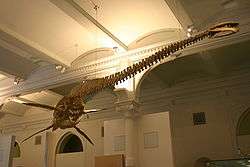Thalassomedon
| Thalassomedon Temporal range: Late Cretaceous, 95 Ma | |
|---|---|
 | |
| Mounted cast of the type specimen, American Museum of Natural History | |
| Scientific classification | |
| Kingdom: | Animalia |
| Phylum: | Chordata |
| Class: | Reptilia |
| Superorder: | †Sauropterygia |
| Order: | †Plesiosauria |
| Family: | †Elasmosauridae |
| Genus: | †Thalassomedon Welles, 1943 |
| Species: | †T. hanningtoni Welles, 1943 |
| Synonyms | |
| |
Thalassomedon is a genus of plesiosaur, named by Welles in 1943. Greek, thalassa, "sea" and Greek, medon, "lord, ruler": Sea lord.
Discovery
This genus of plesiosaur occurred in North America about 95 mya. It occurs in the Cenomanian strata of the Late Cretaceous rock. Its closest relative is the Elasmosaurus and together they make up the family Elasmosauridae. There are six specimens of varying state of preservation on display at various U.S. museums.
Anatomy

With a length of 12 metres (39 ft), the neck comprises 62 vertebrae[1] about 6 metres (20 ft) or half the animal. The skull is 47 centimetres (19 in) long, with 5 centimetres (2.0 in) long teeth. The flippers were about 1.5–2 metres (4.9–6.6 ft) long. Stones have been found in its stomach area leading some to theorize that they were used for ballast or digestion. If the latter, stomach action causes the stones to help grind ingested food.
See also
References
- ↑ Carpenter, K. (1999). "Revision of North American elasmosaurs from the Cretaceous western interior." Paludicola, 2(2): 148-173.
External links
- The skeleton
- About plesiosaurs
- More of the skeleton
- Thalassomedon article with size comparison to a person
| ||||||||||||||||||||||||||||||||||||||||||||||||||||||||||||||||||||||||||||||||||||||||||||||||||||||||